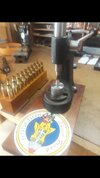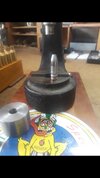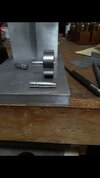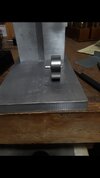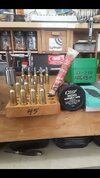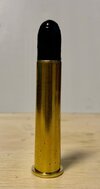JimGnitecki
Member
- Joined
- Mar 28, 2010
- Messages
- 1,258
I just changed over to a new bullet mold for casting: The Lyman #457125, which is a 500g bullet for use in .45-70 Sharps replica rifles like my Pedersoli rifle.
The COAL spec, per Lyman itself in the Lyman Cast Bullet Handbook, is 2.835". I loaded 4 test cartridges to that exact dimension. They will not chamber. They each stop going into the chamber with about 3/16" still protruding.
My best buddy just spent about 40 minutes with me on the phone helping me try to figure out WHY.
We reasoned that the only difference between this handload and the last one (which chambered just fine) is this bullet. It replaces a 485g Lee hand cast bullet that had a notably "sharper ogive profile. Here's a photo with the pointy bullet and the Lyman 457125:
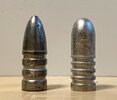
Note that the prior bullet has a MUCH "skinnier' head, making it far easier to chamber of course.
Please disregard the conditon of the prior bullet. It has been filed and then hardness tested, hence the flat spots and dimples in its shank.
BUT, the 500g Lyman bullet is supposed to work just fine in a Sharps or Rolling Block or Trapdoor rifle.
We know that the shank OD of bullet is an actual measured .4595" after going through the Lee .460" sizing die (same sizing die as used for the prior bullet). But of course the sizing die does NOT do any sizing on the ogive. I reasoned that perhaps the powder coating has added just enough thickness to the new bullet's ogive to perhaps make it a tight fit. So, I did take a properly resized case, belled its mouth, seated an UNcoated Lyman bullet in it to the exactly correct 2.835" COAL, and tired to insert it into the chamber. It did go FURTHER in than the powdercoatd bullets did, but is still more than a 1/16" and less than 1/8" from fully chambering.
SO, it APPEARS that despite this being a bullet that should chamber just fine in my rifle, for some reason it does not. I am presuming it is contacting either the rifling or the throat.
I know I can try to "force" it the rest of the way into the chamber, but that would create some problems:
- No jump, which means the peak firing pressure would increase before the bullet starts to move, and COULD possibly end up being too high
- No way to extract an unfired round except by pushing it out via a brass rod from the muzzle
It has akso occurred to me that simply seating the bullet deeper into the case could alleviate the problem. The peak pressures with the loads I am planning to ladder test are, per the loading tables, in the 14,000 to 18,000 psi range. But would seating the bullet deeper potentially raise the peak pressures enough to be unsafe?
This Lyman bullet is apparently virtually a copy of the 1870s 500g bullet used by the U.S. Military to replace the 405g bullet in the 45-70 Trapdoor rifles, to enable "volley fire" to 1000 yards. Its bulbuous shape and its 1.316" length were designed for black powder. Hence the 4 lubricant grooves and the high momentum 500g weight. Maybe reducing the amount of free space between the base of the bulelt and the modest 21g to 27g charges of 5744 powder would actually help?
Any of you have expertise that could help me here?
Don't tell me to return to the slimmer Lee bullet. It is great on accuracy at 100 yards (3-shot groups as small as 0.62"), but goes through the transonic region starting at 125 yards and fails to group at any distance past that.
Jim G
The COAL spec, per Lyman itself in the Lyman Cast Bullet Handbook, is 2.835". I loaded 4 test cartridges to that exact dimension. They will not chamber. They each stop going into the chamber with about 3/16" still protruding.
My best buddy just spent about 40 minutes with me on the phone helping me try to figure out WHY.
We reasoned that the only difference between this handload and the last one (which chambered just fine) is this bullet. It replaces a 485g Lee hand cast bullet that had a notably "sharper ogive profile. Here's a photo with the pointy bullet and the Lyman 457125:

Note that the prior bullet has a MUCH "skinnier' head, making it far easier to chamber of course.
Please disregard the conditon of the prior bullet. It has been filed and then hardness tested, hence the flat spots and dimples in its shank.
BUT, the 500g Lyman bullet is supposed to work just fine in a Sharps or Rolling Block or Trapdoor rifle.
We know that the shank OD of bullet is an actual measured .4595" after going through the Lee .460" sizing die (same sizing die as used for the prior bullet). But of course the sizing die does NOT do any sizing on the ogive. I reasoned that perhaps the powder coating has added just enough thickness to the new bullet's ogive to perhaps make it a tight fit. So, I did take a properly resized case, belled its mouth, seated an UNcoated Lyman bullet in it to the exactly correct 2.835" COAL, and tired to insert it into the chamber. It did go FURTHER in than the powdercoatd bullets did, but is still more than a 1/16" and less than 1/8" from fully chambering.
SO, it APPEARS that despite this being a bullet that should chamber just fine in my rifle, for some reason it does not. I am presuming it is contacting either the rifling or the throat.
I know I can try to "force" it the rest of the way into the chamber, but that would create some problems:
- No jump, which means the peak firing pressure would increase before the bullet starts to move, and COULD possibly end up being too high
- No way to extract an unfired round except by pushing it out via a brass rod from the muzzle
It has akso occurred to me that simply seating the bullet deeper into the case could alleviate the problem. The peak pressures with the loads I am planning to ladder test are, per the loading tables, in the 14,000 to 18,000 psi range. But would seating the bullet deeper potentially raise the peak pressures enough to be unsafe?
This Lyman bullet is apparently virtually a copy of the 1870s 500g bullet used by the U.S. Military to replace the 405g bullet in the 45-70 Trapdoor rifles, to enable "volley fire" to 1000 yards. Its bulbuous shape and its 1.316" length were designed for black powder. Hence the 4 lubricant grooves and the high momentum 500g weight. Maybe reducing the amount of free space between the base of the bulelt and the modest 21g to 27g charges of 5744 powder would actually help?
Any of you have expertise that could help me here?
Don't tell me to return to the slimmer Lee bullet. It is great on accuracy at 100 yards (3-shot groups as small as 0.62"), but goes through the transonic region starting at 125 yards and fails to group at any distance past that.
Jim G


